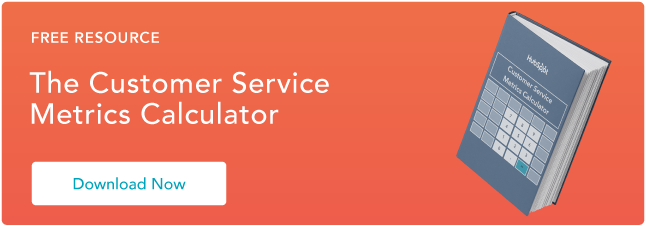Average handle time is one of the more popular metrics that customer support and service teams track for good reason.
Think about the next call that your rep will take. Do you want it to be fast or good?
The correct answer is both—because your customers expect both. In this post, we'll break down what average handle time is, how to calculate it, and how you can cut it in half at your company.
→ Download Now: Customer Service Metrics Calculator [Free Tool]
→ Download Now: Customer Service Metrics Calculator [Free Tool]
Average Handle Time Industry Standard
Average Handle Time (AHT)
Average handle time (AHT) is a metric that measures the average amount of time needed to resolve a support request. This includes time spent on hold, delays, or follow-up actions to fulfill the customer's needs. AHT is typically used in call centers to determine the average length of calls, but you can also use it to analyze chat and email queues.
Why is average handle time important?
Average handle time provides unique insight into how efficient your support and service interactions are for your customers. It‘s an important metric to keep track of if you wish to improve your customer’s experience with your brand.
Average handle time is also an essential customer service metric because it takes into account the customer's most valued commodity: time.
Nowadays, customers expect to engage with someone immediately when seeking support. By measuring AHT, you can monitor how well your customer service team meets this demand and if you don't, you can adjust your support and service offers.
Reducing your AHT often means that your customer service team is being more productive. Customers aren't spending as much time on the phone with your reps and your team is solving cases at a faster rate. This not only improves the experience for the customer but also allows your reps to take on more cases in their daily workflow.
Now that you understand why average handle time is a key customer service metric, you'll probably want to know how to calculate it for your service channels. Below is the formula you can use to calculate AHT in your business.
Average Handle Time Formula
To calculate AHT for a phone channel, divide the sum of your total talk, hold, and follow-up time by your total number of calls. Follow-up time includes the time it takes to get back to a customer if the case isn’t resolved on the initial call or chat. For chat, add your total amount of chat and follow-up time, then divide that number by your total number of chats. For web and email tickets, add the total amount of time spent on each case and divide it by your total number of cases.
ATH = Talk + Hold + Follow-Up / Total Number of Calls
.jpeg)
How to Calculate Average Handle Time
While the math is essentially the same, the variables you use in the average handle time formula will vary slightly depending on the communication medium you‘re evaluating. For example, let’s say I have a business that offers phone, email, and chat support options. We can calculate the AHT for each of these channels using a similar, but not identical, formula.
Average Handle Time Formula for Phone Calls
Let's start with the phones. My phone team fielded 200 calls this week. When we add up the values for each call together, we see that the total amount of talk time was 1,000 minutes, hold time was 500 minutes, and follow-up time was 500 minutes.
If we were to calculate AHT for my phone team, we can see that it would be 10 minutes per call [(1000 talk minutes + 500 hold minutes + 500 follow-up minutes)/200 calls = 10 minutes].
Average Handle Time Formula for Emails
Next, let's look at email. For email, there are no hold times; there’s only follow-up. So, we would measure AHT by adding up the total time it took to resolve each case, starting from when it was first opened.
For example, my business received 500 email tickets and took 10K minutes to resolve them all. In this case, AHT would be 20 minutes per email (10,000 minutes / 500 emails = 20 minutes).
Average Handle Time Formula for Chat Support
Finally, we can measure chat AHT using the same formula as email. Like email, there's no hold time on chat, only talk and follow-up time.
So, my business took 300 chats and spent 2,000 minutes talking to customers and 2,000 minutes following up with them. The AHT for my chat channel would then be about 13 minutes per chat [(2,000 talk minutes + 2,000 follow-up minutes) / 300 chats = 13.33 minutes].
You can use this formula to calculate and compare the AHT of each of your service mediums. However, how do you know if your company's AHT is on par with other businesses in your industry? In the next section, we put together some industry standards you can review to see if your team is resolving cases as fast as your competitors are.
Average Handle Time Industry Standard
Many factors go into calculating an industry standard average handle time. Call Centre Magazine has come closest to offering a baseline number for all industries with its Erlang Calculator, where service teams can enter various metrics to calculate the number of staff required to reach its agreed service levels.
When it comes to industry standards, the number is tougher to calculate. Krisp used data from Talkdesk’s 2021 Global Contact Center KPI Benchmarking Report to calculate industry averages. Still, it’s important to note that after-call work times are not included in the report, so it couldn’t be used in the equation. The table below shows the average talk time divided by the average hold time by industry.
| INDUSTRY |
AHT |
| Consumer/Professional services |
3 minutes, 36 seconds |
| Financial services |
4 minutes, 5 seconds |
| Government & Public Sector |
4 minutes, 12 seconds |
| Healthcare |
3 minutes, 28 seconds |
| Hospitality |
3 minutes, 11 seconds |
| Manufacturing |
4 minutes, 13 seconds |
| Media & Communications |
3 minutes, 30 seconds |
| Retail, Ecommerce, and Consumer Goods |
3 minutes, 29 seconds |
| Telecommunications |
2 minutes, 36 seconds |
| Transportation and Logistics |
4 minutes, 8 seconds |
| Other |
1 minute, 21 seconds |
What is a good average handle time?
A good average handle time depends on your industry average. If you’re below the average or at it, you’re bringing your customers quick solutions. If you’re higher than average, you take a bit more time to close tickets and could stand to assess your processes for growth opportunities.
.png)
It’s essential to assess your average handle time in relation to other metrics like customer satisfaction to get a complete picture of your support practices and see if customers are satisfied with the support they receive.
If your business seems to be falling short of industry standards, take a look at the next section for some tips you can use to reduce average handle time at your company.
Average Handle Time Tips
Many businesses constantly try to reduce average handle time but struggle to find effective results. The truth is, there‘s no shortcut to fulfilling a customer’s needs but there are measures your team can take to deliver solutions faster. Below are some average handle time tips you can use to create a quicker customer experience with your support and service teams.
1. Provide proactive customer service.
Proactive customer service is one of the most effective ways to reduce average handling time. These are instances where your service team is providing support to your customers without the customer reaching out first. That way when your customers do need help, your team is already prepared to resolve their issue.
How to implement this tip:
One great example of proactive customer service is providing your customers with a knowledge base. A knowledge base is a portion of your website that's dedicated to answering common questions that your customers may have about your product or services. If a customer calls in with one of these questions, the service rep can provide a brief explanation and direct them to the knowledge base rather than spending the time to walk through the entire answer. This saves your rep from having to repeat simple and repetitive steps that customers can take on their own.
2. Create guides for your reps.
Just because you have a knowledge base for your customers doesn‘t mean that your customer service team doesn’t need one either. You can create an internal knowledge base that includes guides and cheat-sheets that only your reps can see. So when customers do call in with those repetitive questions, your rep will know exactly what to say and do for the customer.
How to implement this tip:
This comes in handy particularly with reducing the average handle time of new or inexperienced customer service reps. At HubSpot, we have a section of our internal knowledge base dedicated to common problems that new reps will most likely experience. When support reps are just starting out, they can quickly navigate to these articles to help them troubleshoot during a call.
3. Adopt customer service tools.
Customer service reps love gizmos and gadgets, especially the ones that make their lives easier at work. Give your team some more tech to play with and adopt customer service tools that will provide them with advanced troubleshooting options like screen-sharing, API goggles, and ticket automation. These additions not only give your support team a technological advantage but can improve the customer's experience as well.
How to implement this tip:
For example, virtual assistants allow your reps to not only share their computer screen with a customer but perform actions on the customer's screen as well. If a customer is having trouble performing troubleshooting steps, the rep can take over their mouse and show them exactly what to do rather than wasting time trying to clarify the steps. Reps can even record the interaction so that the customer can replay the explanation should they need it again.
Don't sacrifice quality for speed.
While it‘s good to be ambitious when reducing average handling time, make sure you’re not sacrificing the quality of your customer service in return. Some reps may be eager to close cases and will rush through troubleshooting steps or cut corners to save time. This often leads to them making mistakes that end up costing them more time and effort as a result. Rather than motivating reps to provide the fastest support possible, focus on providing the most-effective support and your team's AHT will take care of itself.
Editor's note: This post was originally published in May 2022 and has been updated for comprehensiveness.
Customer Service Metrics
.png?width=112&height=112&name=Image%20Hackathon%20%E2%80%93%20Vertical%20(85).png)


![11 Customer Service & Support Metrics You Must Track [New Data]](https://53.fs1.hubspotusercontent-na1.net/hubfs/53/ft-metrics.webp)


![Confused about customer acquisition cost? I asked experts about CAC to help [+ benchmarks and formulas]](https://53.fs1.hubspotusercontent-na1.net/hubfs/53/%5BUse%20(2)-3.webp)
![What Is a Customer Service Self-Evaluation? [+Examples]](https://53.fs1.hubspotusercontent-na1.net/hubfs/53/customer-service-self-evaluation.jpg)